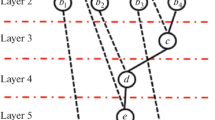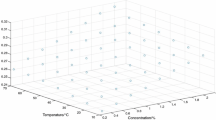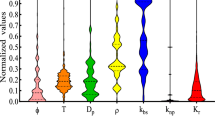Abstract
The suspension of the nanoparticles in the conventional heat transfer fluids results in the increment of the fluids' thermal conductivity, viscosity, and density of the fluid. These improvements in thermophysical properties have enormous technological benefits. The thermal fluid properties depend upon a host of parameters such as volume fraction of the nanoparticles, temperature, density of fluid base and nanoparticles, nanoparticles size, nanolayer, the thermal conductivity of base fluid and particles, and pH. Studying the properties of the thermal fluids via experiments is a laborious task that can be simplified using predictive modeling. In this study, a machine learning regressive model named Gradient Boost Regression (GBR) is developed to predict the density of the aluminum nitride (Al2N3), silicon nitride (Si3N4), and titanium nitride (TiN) nanoparticles suspended in ethylene glycol (EG) solution. The predictive model developed is used to predict the density of the nanofluid based on four parameters; the size of nanoparticles, the molecular weights of nanoparticles, the volume concentration of the particle, and temperature. The proposed predictive model predicted the density of nanofluids for the training dataset with 99.99 percent accuracy whereas the testing dataset was validated at 99.91% accuracy and a standard deviation of 0.0000783 from the experimental data. To highlight the accuracy of the proposed model, its predictive performance was compared with an existing model formulated by Pak and Cho. The Pak & Cho model has a mean absolute deviation (MAD) of 0.0397 whereas the proposed GBR model has a MAD value of 0.0000783 for the estimated density of the nanofluids. Finally, the developed GBR model was compared with experimental density values at different temperatures and mass concentrations (0–5%). The proposed (GBR) model agrees well with experimental results under the different experimental conditions.







Similar content being viewed by others
References
S.U.-S. Choi, J.A. Eastman, Enhancing Thermal Conductivity of Fluids with NPs, (1995)
C. Qi, K. Li, C. Li, B. Shang, Y. Yan, Experimental study on thermal efficiency improvement using nanofluids in heat sink with heated circular cylinder. Int. Commun. Heat Mass Transfer 114, 104589 (2020)
X.X. Tian, R. Kalbasi, R. Jahanshahi, C. Qi, H.L. Huang, S. Rostami, Competition be- tween intermolecular forces of adhesion and cohesion in the presence of graphene nanoparticles: investigation of graphene nanosheets/ethylene glycol surface tension. J. Mol. Liq. 311, 113329 (2020)
X.X. Tian, R. Kalbasi, C. Qi, A. Karimipour, H.L. Huang, Efficacy of hybrid nanopowder presence on the thermal conductivity of the engine oil: an experimental study. Powder Technol. 369, 261–269 (2020)
F. Soltani, D. Toghraie, A. Karimipour, Experimental measurements of thermal conductivity of engine oil-based hybrid and mono nanofluids with tungsten oxide (WO3) and MWCNTs inclusions. Powder Technol. 371, 37–44 (2020). https://doi.org/10.1016/j.powtec.2020.05.059
I.O. Alade, T.A. Oyehan, I.K. Popoola, S.O. Olatunji, A. Bagudu, Modeling thermal conductivity enhancement of metal and metallic oxide nanofluids using support vector regression. Adv. Powder Technol 29(1), 157–167 (2018)
I.O. Alade, M.A. Abd Rahman, Z. Abbas, Y. Yaakob, T.A. Saleh, Application of support vector regression and artificial neural network for prediction of specific heat capacity of aqueous nanofluids of copper oxide. Sol. Energy 197, 485–490 (2020). https://doi.org/10.1016/j.solener.2019.12.067
M. Jamei, M. Karbasi, I. Adewale Olumegbon, M. Moshraf-Dehkordi, I. Ahmadianfar, A. Asadi, Specific heat capacity of molten salt-based nanofluids in solar thermal applications: a paradigm of two modern ensemble machine learning methods. J. Mol. Liq. 335, 116434 (2021). https://doi.org/10.1016/j.molliq.2021.116434
M. Jamei, I. Ahmadianfar, I.A. Olumegbon, A. Asadi, M. Karbasi, Z. Said, J.P. Meyer, On the specific heat capacity estimation of metal oxide-based nanofluid for energy perspective–A comprehensive assessment of data analysis techniques. Int. Commun. Heat Mass Transfer 123, 105217 (2021)
M. Jamei, I.A. Olumegbon, M. Karbasi, I. Ahmadianfar, A. Asadi, M. Mosharaf-Dehkordi, On the thermal conductivity assessment of oil-based hybrid nanofluids using extended Kalman filter integrated with feed-forward neural network. Int. J. Heat Mass Transf. 172, 121159 (2021)
M. Jamei, M. Karbasi, M. Mosharaf-Dehkordi, I.A. Olumegbon, L. Abualigah, Z. Said, A. Asadi, Estimating the density of hybrid nanofluids for thermal energy application: application of non-parametric and evolutionary polynomial regression data-intelligent techniques. Measurement 189, 110524 (2022)
I.M. Mahbubul, R. Saidur, M.A. Amalina, Thermal conductivity, viscosity and density of R141b refrigerant based nanofuid. Procedia Eng. 56, 310–315 (2013)
V. Kumaresan, R. Velraj, Experimental investigation of the thermo-physical properties of water–ethylene glycol mixture based CNT nanofluids. Thermochim. Acta 545, 180–186 (2012)
G. Żyła, J.P. Vallejo, L. Lugo, Isobaric heat capacity and density of ethylene glycol based nanofluids containing various nitride nanoparticle types: an experimental study. J. Mol. Liq. 261, 530–539 (2018). https://doi.org/10.1016/j.molliq.2018.04.012
D. Yadav, A. Nirala, R. Kumar, P. Kumar Singh, Density variation in nanofluids as a function of concentration and temperature. Mater. Today: Proc. 46, 6576–6580 (2021). https://doi.org/10.1016/j.matpr.2021.04.052
T. Wen, G. Zhu, K. Jiao, L. Lu, Experimental study on the thermal and flow characteristics of ZnO/water nanofluid in mini-channels integrated with GA-optimized ANN prediction and CFD simulation. Int. J. Heat Mass Transf. 178, 121617 (2021). https://doi.org/10.1016/j.ijheatmasstransfer.2021.121617
T. Wen, G. Zhu, L. Lu, Experimental and artificial neural network based study on the heat transfer and flow performance of ZnO-EG/water nanofluid in a mini-channel with serrated fins. Int. J. Therm. Sci. 170, 107149 (2021). https://doi.org/10.1016/j.ijthermalsci.2021.107149
T. Salameh, P.P. Kumar, E.T. Sayed, M.A. Abdelkareem, H. Rezk, A.G. Olabi, Fuzzy modeling and particle swarm optimization of Al2O3/SiO2 nanofluid. Int. J.f Thermofluids 10, 100084 (2021). https://doi.org/10.1016/j.ijft.2021.100084
Krishna Kumar Mahto (2019). Demystifying Maths of Gradient Boosting. Towards to Data Science. https://towardsdatascience.com/demystifying-maths-of-gradient-boosting-bd5715e82b7c .
V.J. Kadam, S.M. Jadhav, Performance analysis of hyperparameter optimization methods for ensemble learning with small and medium sized medical datasets. J. Discr. Math. Sci. Cryptogr. 23(1), 115–123 (2020). https://doi.org/10.1080/09720529.2020.1721871
F. Fan, C. Qi, J. Tang, Qi. Liu, X. Wang, Y. Yan, A novel thermalefficiency analysis on the thermo-hydraulic performance of nanofluids in an im- proved heat exchange system under adjustable magnetic field. Appl. Thermal Eng. 179, 115688 (2020)
C. Pak, Y.I. Cho, Hydrodynamic and heat transfer study of dispersed fluids with submicron metallic oxide particles. Exp. Heat Transfer an Int. J. 11(2), 151–170 (1998)
R. Alizadeh, J.M.N. Abad, A. Ameri, M.R. Mohebbi, A. Mehdizadeh, D. Zhao, N. Karimi, A machine learning approach to the prediction of transport and thermodynamic processes in multiphysics systems—Heat transfer in a hybrid nanofluid flow in porous media. J. Taiwan Inst. Chem. Eng. 124, 290–306 (2021). https://doi.org/10.1016/j.jtice.2021.03.043
A. Altun, O.N. Şara, B. Şimşek, A comprehensive statistical approach for determining the effect of two non-ionic surfactants on thermal conductivity and density of Al2O3–water-based nanofluids. Coll. Surf. A 626, 127099 (2021). https://doi.org/10.1016/j.colsurfa.2021.127099
A. Banisharif, P. Estellé, A. Rashidi, S. Van Vaerenbergh, M. Aghajani, Heat transfer properties of metal, metal oxides, and carbon water-based nanofluids in the ethanol condensation process. Coll. Surf. A 622, 126720 (2021). https://doi.org/10.1016/j.colsurfa.2021.126720
S.S. Chawhan, D.P. Barai, B.A. Bhanvase, Investigation on thermophysical properties, convective heat transfer and performance evaluation of ultrasonically synthesized Ag-doped TiO2 hybrid nanoparticles based highly stable nanofluid in a minichannel. Ther. Science Eng. Progr. (2021). https://doi.org/10.1016/j.tsep.2021.100928
P. Ganesh Kumar, D. Sakthivadivel, N. Thangapandian, M. Salman, A. Kumar Thakur, R. Sathyamurthy, S. Chul Kim, Effects of ultasonication and surfactant on the thermal and electrical conductivity of water – Solar glycol mixture based Al2O3 nanofluids for solar-thermal applications. Sustain. Energy Technol. Assess. (2021). https://doi.org/10.1016/j.seta.2021.101371
M. Hemmat Esfe, S. Esfandeh, M. Hassan Kamyab, D. Toghraie, Analysis of rheological behavior of MWCNT-Al2O3 (10:90)/5W50 hybrid non-Newtonian nanofluid with considering viscosity as a three-variable function. J. Mol. Liq. (2021). https://doi.org/10.1016/j.molliq.2021.117375
H. Jiang, X. Hou, D. Su, H. Liu, M.K.A. Ali, Elucidation of the thermophysical mechanism of hexagonal boron nitride as nanofluids additives. Adv. Powder Technol. 32(8), 2816–2827 (2021). https://doi.org/10.1016/j.apt.2021.05.049
R. Lenin, P.A. Joy, C. Bera, A review of the recent progress on thermal conductivity of nanofluid. J. Mol. Liq. 338, 116929 (2021). https://doi.org/10.1016/j.molliq.2021.116929
A.B. Mahfouz, Viscosity prediction and optimization of ZnO-coconut oil nanofluids using numerical simulation. Mater. Today: Proc. 42, 1437–1441 (2021). https://doi.org/10.1016/j.matpr.2021.01.239
P.C. Mukesh Kumar, B. Rajappa, A review on prediction of thermo physical properties of heat transfer nanofluids using intelligent techniques. Mater. Today: Proc. 21, 415–418 (2020). https://doi.org/10.1016/j.matpr.2019.06.379
M. Nabavi, M. Elveny, S.D. Danshina, I. Behroyan, M. Babanezhad, Velocity prediction of Cu/water nanofluid convective flow in a circular tube: Learning CFD data by differential evolution algorithm based fuzzy inference system (DEFIS). Int. Commun. Heat Mass Transfer 126, 105373 (2021). https://doi.org/10.1016/j.icheatmasstransfer.2021.105373
S. Safarzadeh, M. Niknam-Azodi, A. Aldaghi, A. Taheri, M. Passandideh-Fard, M. Mohammadi, Energy and entropy generation analyses of a nanofluid-based helically coiled pipe under a constant magnetic field using smooth and micro-fin pipes: experimental study and prediction via ANFIS model. Int. Commun. Heat Mass Transfer 126, 105405 (2021). https://doi.org/10.1016/j.icheatmasstransfer.2021.105405
M. Sahaluddin, I.O. Alade, M.O. Oyedeji, U.S. Aliyu, A machine learning-based model to estimate the density of nanofluids of nitrides in ethylene glycol. J. Appl. Phys. 127(20), 205105 (2020). https://doi.org/10.1063/5.0002753
R.D. Selvakumar, J. Wu, A comprehensive model for effective density of nanofluids based on particle clustering and interfacial layer formation. J. Mol. Liq. 292, 111415 (2019). https://doi.org/10.1016/j.molliq.2019.111415
G. Sodeifian, Z. Niazi, Prediction of CO2 absorption by nanofluids using artificial neural network modeling. Int. Commun. Heat Mass Transfer 123, 105193 (2021). https://doi.org/10.1016/j.icheatmasstransfer.2021.105193
A.A. Taheri, A. Abdali, M. Taghilou, H. Haes Alhelou, K. Mazlumi, Investigation of mineral oil-based nanofluids effect on oil temperature reduction and loading capacity increment of distribution transformers. Energy Rep. 7, 4325–4334 (2021). https://doi.org/10.1016/j.egyr.2021.07.018
H. Wang, Z. Rao, W. Wang, S. Liao, A reconstruction of Hamilton-Crosser model for effective thermal conductivity of nanofluids based on particle clustering and nanolayer formation. Case Stud. Ther. Eng. 26, 101051 (2021). https://doi.org/10.1016/j.csite.2021.101051
X. Wang, L. Luo, J. Xiang, S. Zheng, S. Shittu, Z. Wang, X. Zhao, A comprehensive review on the application of nanofluid in heat pipe based on the machine learning: theory, application and prediction. Renew. Sustain. Energy Rev. 150, 111434 (2021). https://doi.org/10.1016/j.rser.2021.111434
Z. Ying, B. He, D. He, Y. Kuang, J. Ren, B. Song, Comparisons of single-phase and two-phase models for numerical predictions of Al2O3/water nanofluids convective heat transfer. Adv. Powder Technol. 31(7), 3050–3061 (2020). https://doi.org/10.1016/j.apt.2020.05.032
X. Yang, A. Boroomandpour, S. Wen, D. Toghraie, F. Soltani, Applying Artificial Neural Networks (ANNs) for prediction of the thermal characteristics of water/ethylene glycol-based mono, binary and ternary nanofluids containing MWCNTs, titania, and zinc oxide. Powder Technol. 388, 418–424 (2021). https://doi.org/10.1016/j.powtec.2021.04.093
F. Soltani, M. Hajian, D. Toghraie, A. Gheisari, N. Sina, A. Alizadeh, Applying Artificial Neural Networks (ANNs) for prediction of the thermal characteristics of engine oil –based nanofluids containing tungsten oxide -MWCNTs. Case Stud. Ther. Eng. 26, 101122 (2021). https://doi.org/10.1016/j.csite.2021.101122
S. Singh, S. Kumar, S.K. Ghosh, Development of a unique multi-layer perceptron neural architecture and mathematical model for predicting thermal conductivity of distilled water based nanofluids using experimental data. Coll. Surf. A 627, 127184 (2021). https://doi.org/10.1016/j.colsurfa.2021.127184
L. Shi, S. Zhang, A. Arshad, Y. Hu, Y. He, Y. Yan, Thermo-physical properties prediction of carbon-based magnetic nanofluids based on an artificial neural network. Renew. Sustain. Energy Rev. 149, 111341 (2021). https://doi.org/10.1016/j.rser.2021.111341
Z. Said, P. Sharma, L. Syam Sundar, A. Afzal, C. Li, Synthesis, stability, thermophysical properties and AI approach for predictive modelling of Fe3O4 coated MWCNT hybrid nanofluids. J. Mol. Liq. 340, 117291 (2021). https://doi.org/10.1016/j.molliq.2021.117291
Z. Said, L.S. Sundar, H. Rezk, A.M. Nassef, H.M. Ali, M. Sheikholeslami, Optimizing density, dynamic viscosity, thermal conductivity and specific heat of a hybrid nanofluid obtained experimentally via ANFIS-based model and modern optimization. J. Mol. Liq. 321, 114287 (2021). https://doi.org/10.1016/j.molliq.2020.114287
Z. Said, L.S. Sundar, A.K. Tiwari, H.M. Ali, M. Sheikholeslami, E. Bellos, H. Babar, Recent advances on the fundamental physical phenomena behind stability, dynamic motion, thermophysical properties, heat transport, applications, and challenges of nanofluids. Phys. Rep. (2021). https://doi.org/10.1016/j.physrep.2021.07.002
A. Kaladgi Razak, A. Afzal, A.M. Manokar, D. Thakur, U. Agbulut, S. Alshahrani, C.A. Saleel, R. Subbiah, Integrated Taguchi-GRA-RSM optimization and ANN modelling of thermal performance of zinc oxide nanofluids in an automobile radiator. Case Stud. Ther. Eng. 26, 101068 (2021). https://doi.org/10.1016/j.csite.2021.101068
K. Maqsood, Multiobjective optimization of thermophysical properties of indonesian fly-ash nanofluid. Mater. Today: Proc. (2021). https://doi.org/10.1016/j.matpr.2021.06.304
M. Malika, S.S. Sonawane, Application of RSM and ANN for the prediction and optimization of thermal conductivity ratio of water based Fe2O3 coated SiC hybrid nanofluid. Int. Commun. Heat Mass Transfer 126, 105354 (2021). https://doi.org/10.1016/j.icheatmasstransfer.2021.105354
V. Kumar, A. Pare, A.K. Tiwari, S.K. Ghosh, Efficacy evaluation of oxide-MWCNT water hybrid nanofluids: an experimental and artificial neural network approach. Coll. Surf., A 620, 126562 (2021). https://doi.org/10.1016/j.colsurfa.2021.126562
W. Ji, L. Yang, Z. Chen, M. Mao, J. Huang, Experimental studies and ANN predictions on the thermal properties of TiO2-Ag hybrid nanofluids: consideration of temperature, particle loading, ultrasonication and storage time. Powder Technol. 388, 212–232 (2021). https://doi.org/10.1016/j.powtec.2021.04.069
M. Jamei, R. Pourrajab, I. Ahmadianfar, A. Noghrehabadi, Accurate prediction of thermal conductivity of ethylene glycol-based hybrid nanofluids using artificial intelligence techniques. Int. Commun. Heat Mass Transfer 116, 104624 (2020). https://doi.org/10.1016/j.icheatmasstransfer.2020.104624
M. Jamei, I. Ahmadianfar, A rigorous model for prediction of viscosity of oil-based hybrid nanofluids. Physica A 556, 124827 (2020). https://doi.org/10.1016/j.physa.2020.124827
K. Jafari, M.H. Fatemi, A new approach to model isobaric heat capacity and density of some nitride-based nanofluids using Monte Carlo method. Adv. Powder Technol. 31(7), 3018–3027 (2020). https://doi.org/10.1016/j.apt.2020.05.023
M. Gholizadeh, M. Jamei, I. Ahmadianfar, R. Pourrajab, Prediction of nanofluids viscosity using random forest (RF) approach. Chemom. Intell. Lab. Syst. 201, 104010 (2020). https://doi.org/10.1016/j.chemolab.2020.104010
A. Ali, S.U. Ilyas, S. Garg, M. Alsaady, K. Maqsood, R. Nasir, A. Abdulrahman, M. Zulfiqar, A.B. Mahfouz, A. Ahmed, S. Ridha, Dynamic viscosity of Titania nanotubes dispersions in ethylene glycol/water-based nanofluids: experimental evaluation and predictions from empirical correlation and artificial neural network. Int. Commun. Heat Mass Transfer 118, 104882 (2020). https://doi.org/10.1016/j.icheatmasstransfer.2020.104882
I.O. Alade, M.A.A. Rahman, A. Hassan, T.A. Saleh, Modeling the viscosity of nanofluids using artificial neural network and Bayesian support vector regression. J. Appl. Phys. 128(8), 085306 (2020)
H. Adun, I. Wole-Osho, E.C. Okonkwo, O. Bamisile, M. Dagbasi, S. Abbasoglu, A neural network-based predictive model for the thermal conductivity of hybrid nanofluids. Int. Commun. Heat Mass Transfer 119, 104930 (2020). https://doi.org/10.1016/j.icheatmasstransfer.2020.104930
Author information
Authors and Affiliations
Corresponding author
Rights and permissions
About this article
Cite this article
Singh, H.M., Sharma, D.P. & Alade, I.O. GBR-GSO based machine learning predictive model for estimating density of Al2N3, Si3N4, and TiN nanoparticles suspended in ethylene glycol nanofluids. Eur. Phys. J. Plus 137, 587 (2022). https://doi.org/10.1140/epjp/s13360-022-02767-8
Received:
Accepted:
Published:
DOI: https://doi.org/10.1140/epjp/s13360-022-02767-8




